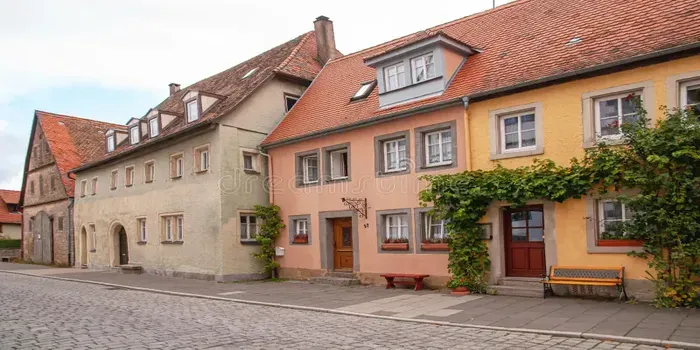5 Historically Significant Houses in Germany
Germany is home to several historically significant houses that offer a glimpse into its rich cultural heritage. Neuschwanstein Castle, nestled in the Bavarian Alps, embodies fairy-tale architecture. Sanssouci Palace in Potsdam reflects Prussian elegance and baroque artistry. The Bauhaus Dessau, a symbol of modernist design, showcases innovative architecture. Wartburg Castle, a UNESCO World Heritage site, played a pivotal role in German history. Lastly, Goethe House in Frankfurt preserves the legacy of the renowned writer Johann Wolfgang von Goethe.

Germany is a country steeped in history, and its architecture reflects the rich tapestry of its past. From medieval castles to modernist masterpieces, the houses that dot the landscape tell stories of political upheaval, artistic movements, and cultural shifts. In this article, we will explore five historically significant houses in Germany, each representing a unique aspect of the nation’s heritage.
1. The Bauhaus Dessau
The Bauhaus Dessau, located in Dessau, was the home of the famous Bauhaus school of design founded by Walter Gropius in 1919. This iconic building is a prime example of modernist architecture and embodies the principles of simplicity and functionality. The Bauhaus movement significantly influenced architecture, design, and art worldwide, promoting the idea that form should follow function.
Visitors to the Bauhaus Dessau can explore its innovative design and learn about the influential figures who taught and studied there. The site is now a UNESCO World Heritage site, highlighting its importance in the history of modern architecture. The Bauhaus Dessau continues to inspire architects and designers globally, making it a must-visit for anyone interested in modernism.
2. The House of Anne Frank in Berlin
While many know Anne Frank from her diary, her house in Berlin offers a poignant glimpse into her life during World War II. The House of Anne Frank is a memorial dedicated to her and the Jewish experience during the Holocaust. The building serves as a museum and a reminder of the atrocities faced by millions during this dark period in history.
Visitors can explore the rooms where Anne lived and wrote her famous diary, gaining insight into her thoughts and experiences. The museum also educates visitors about the broader context of the Holocaust, ensuring that such history is never forgotten. The House of Anne Frank is a powerful testament to resilience and the importance of remembering the past.
3. The Neuschwanstein Castle
Perched on a hill in Bavaria, Neuschwanstein Castle is one of the most recognized castles in the world and a symbol of romantic architecture. Commissioned by King Ludwig II in the 19th century, it was inspired by the operas of Richard Wagner and embodies the fairy-tale aesthetic. The castle's stunning towers and picturesque setting make it a popular tourist destination.
Neuschwanstein Castle also represents the idealization of medieval architecture during the Romantic period. Visitors can explore its opulent interiors and learn about the life of King Ludwig II, whose enigmatic personality adds to the castle's allure. This architectural marvel attracts millions of visitors each year, solidifying its status as a symbol of Germany's cultural heritage.
4. The Goethe House in Frankfurt
The Goethe House, located in Frankfurt, is the birthplace of Johann Wolfgang von Goethe, one of Germany's most celebrated writers and thinkers. This well-preserved building offers a glimpse into the life of the literary giant and the environment that shaped his work. It has been transformed into a museum showcasing Goethe's life, his literary contributions, and the cultural context of his time.
Visitors can explore the beautifully restored rooms, filled with period furniture and artifacts. The museum also hosts exhibitions related to Goethe and the German literary tradition, highlighting the impact of his work on literature and philosophy. The Goethe House serves as a cultural landmark, celebrating the legacy of one of Germany's most significant figures.
5. The Schiller House in Weimar
The Schiller House, located in Weimar, is where the famous poet Friedrich Schiller lived and wrote for several years. This historic house is a testament to the Weimar Classicism movement and the cultural flourishing that occurred in Germany during the late 18th and early 19th centuries. The house has been preserved as a museum, showcasing Schiller’s life, work, and the artistic circles that surrounded him.
Visitors can explore the rooms where Schiller created some of his most important works and learn about the collaborative relationship he had with Goethe. The Schiller House is a vital part of Germany's literary heritage, representing the profound impact of literature on the nation’s identity. It also highlights the importance of Weimar as a cultural hub during this vibrant period.
| House | Location | Significance |
|---|---|---|
| Bauhaus Dessau | Dessau | Modernist architecture and design |
| House of Anne Frank | Berlin | Holocaust memorial and museum |
| Neuschwanstein Castle | Bavaria | Romantic architecture and fairy-tale aesthetic |
| Goethe House | Frankfurt | Birthplace of Johann Wolfgang von Goethe |
| Schiller House | Weimar | Home of poet Friedrich Schiller |
These five historically significant houses in Germany offer a glimpse into the nation's rich cultural and architectural heritage. From the modernist ideals of the Bauhaus Dessau to the literary legacy of Goethe and Schiller, each house tells a unique story that contributes to the broader narrative of Germany’s history. For travelers and history enthusiasts alike, visiting these sites provides an opportunity to connect with the past and appreciate the profound impact these individuals and movements have had on the world.












